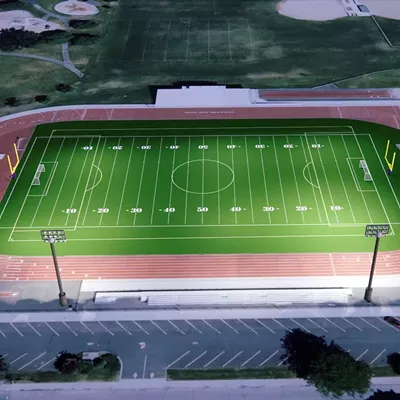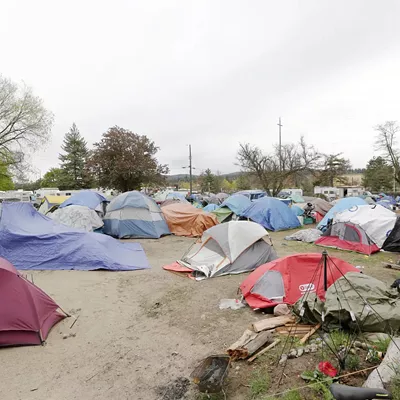Stronger Together
The two "Think Big" items -- "Merge Two Cities" and "One Big Happy Chamber" (1/20/05) -- both have the right idea, but don't carry it far enough. At a certain point in the development of a largely urban county or metropolitan area, the concept of a city as a form of government becomes hopelessly inefficient and self-defeating. Southern California has suffered from this for years -- a patchwork border-to-border quilt of small city-kingdoms, each with its own inflated sense of self-importance and competing with other cities rather than working for the common good of the region.
I lived in King County for 15 years before returning to my native Spokane and watched many a small city come into existence over there -- in the Seattle area, they all struggled with finances (usually within 18 months of incorporation) and discovered too late that the noble ideal of self-determination does little to provide adequate services or to result in the necessary clout for impacting the economic health of the city -- not without joining forces with other governments in the region.
The situation in King County has deteriorated to the point where only about 20 percent of the population lives outside a city. Several rather extreme citizen-backed measures are underway to counteract what is regarded as the negative effects of too many governments employing too many professional politicians, with each one trying to rule the roost. The process of forming new cities would be helped by more honesty and integrity.
Mike Almond
Spokane, Wash.
Not So "Underutilized"
Your article "Embrace Our Regional Heritage" (1/20/05), was a thoughtful and interesting commentary. However, I must point out the fallacy of characterizing the Washington Water Power building as "underutilized" and proposing alternate uses for the structure.
The building is actually a vital substation serving most of the downtown core. This is where power produced in the Monroe Street and Upper Falls generating stations is distributed to users. The building houses the essential equipment for this purpose and is not suitable for mixed uses. This is true for a variety of reasons including safety and security.
Currently Avista is in the midst of a $5 million upgrade to the building and its equipment. This is an investment in the future reliability of electric energy in the downtown area.
We at Avista are heartened to see the increased attention to the Spokane River, and support appropriate uses of lands along the river. We are working closely with stakeholders in our current re-licensing process to develop the best plan for future hydro operations.
Hugh Imhof
Spokesman, Avista Corp.
Spokane, Wash.
Creative Juices Are Flowing
Here are my two cents on the "What's the Big Idea?" issue. I think Spokane needs to embrace its historical heritage to move the city forward. This can be done in numerous ways.
First, I envision the Spokane streetcar system returning, linking downtown to past and new streetcar lines (Gonzaga, West Central and Browne's Addition, for example). Some of the old rail lines can still be seen in certain parts of the near South Hill. New and vintage streetcars could be obtained to provide the service. This would enhance Spokane's image and provide a vital transportation mode to reduce traffic and boost the downtown area. People would return to the streets instead of their vehicles. The streetcar lines would eventually link parts of the city to light rail routes to the Valley, the airport and northbound routes (such as the Maple/Ash corridor). In addition, by taking the asphalt down to the still-present original bricks, we could give certain districts a historical flavor that existed a century ago.
Another way to move the city forward by connecting to its past is to redevelop the older homes that are close to the city center, such as the near South Hill, West Central and East Central. Federal grants could be obtained to fix run-down neighborhoods. These would be great starter homes for younger people, provide ownership to residents and spruce up the city. It would also increase the city's population. Restoring older business buildings in all parts of the city will continue to show respect to Spokane's historical heritage -- something neglected by other cities, such as Boise and San Jose. Spokane has a rich historical heritage. Let's build on it and educate the residents and visitors to this region. Spokane residents in 2105 will thank us for investing in the future!
Daniel L. Bielenberg
Spokane, Wash.
Market This!
A couple of weeks ago, you posted comments by locals about what Spokane needs ("Think Big," 1/20/05). I've given this a lot of thought, since I moved here 10 years ago, and one of my ideas is a permanent farmers' market, a la Pike Street Market in Seattle. Not just anywhere, but on the far east side of the Summit (if it ever gets going) project, right near the Monroe Street Bridge. With more people moving downtown, lofts being developed, etc., this would be an ideal place for people to shop. The area already has interesting antique stores. I can see bakeries, restaurants, and crafts and, of course, fresh produce. I think it would be a fantastic draw for locals and tourists. I would love to see it happen.
Katy Sharpe
Spokane, Wash.
Great Follies
When the permits for the Burlington Northern-Santa Fe refueling depot on the Rathdrum Prairie were being discussed, I was astounded that such a project, over the sole-source aquifer for a half a million people in our region, would ever be seriously considered. When the Kootenai County Commissioners were deliberating, I was convinced they had better sense. If someone had asked to bet me that such a potentially hazardous project would ever get the green light, I would have laid a wager against its advent. I had a misguided faith in Idaho's leaders. To me, the mere proposal of the refueling depot was just another symbolic and contrary gesture on the part of Idaho politicians -- just another stick in the eye of the federal government and the public.
Later, when it looked as if those county commissioners would be foolish enough to approve the move, my distaste was great. I resolved that I would take my family and leave this region if the project ever came to pass, for I did not want to be part of a community where such folly could ever be a outcome of a county planning processes. But I stayed; I swallowed my bitter spit.
I underestimated the shortsightedness of the state of Idaho, and I overestimated the farsightedness of Washington state's governor, Gary Locke, and its Department of Ecology director, Tom Fitzsimmons. When the Kootenai County commissioners actually approved the project, I remained certain that public input or litigation could still halt the folly.
My hopes were dashed, the refueling depot was built and then opened for business, and last summer I drove over to see it. I needed ocular evidence, empirical proof, that the technocrats had had their way. Three months later, the first leak appeared; I'm sure it won't be the last.
Here's hoping that the resolution of the Spokane City Council will prove to be more than simply symbolic. Here is a vote of confidence in our Council's willingness to take the firmest possible resolve against the wayward politicians on the other side of the state line.
Paul Lindholdt
Spokane Wash.
Knit Wits
I loved Sheri Boggs and Leah Sottile's articles on knitting and other crafty things, "Eclectic Domestic" (1/27/05). I just recently learned to knit by joining a Stitch-N-Bitch group which has a Yahoo group: http://groups.yahoo.com/group/stitchnbitchspokane.
It was threatening to become a lost art. I'm so glad that it did not fall by the wayside in our throwaway culture. I'm so glad I learned how to knit. And I was so glad to read the lovely article in The Inlander.
Leetah Gray
Spokane, Wash.
Publication date: 02/10/05
















